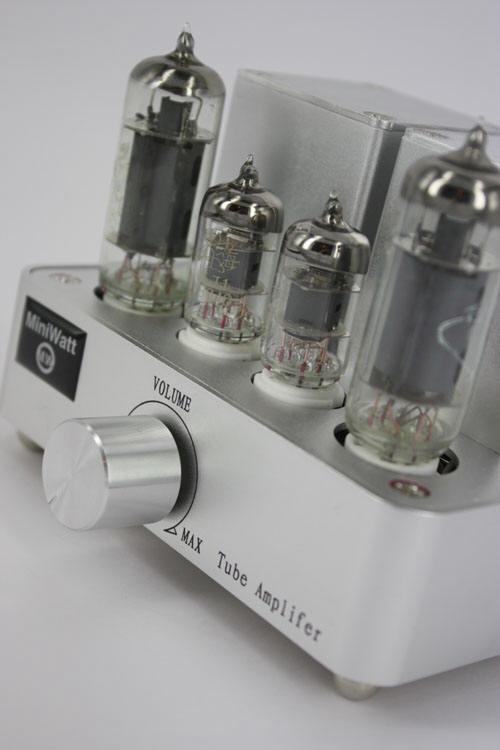|
You are reading the older HTML site Positive Feedback ISSUE 46november/december 2009
Minnie: the Integrated
MiniWatt Amplifier
If I told you I have heard, in my system, in my very listening room, through my ears and brain, a super fly-weight 2.5 Watts/channel amplifier that delivers enough signal to drive some pretty efficient speakers to very loud levels, you might say I am nuts. More than that, if I told you this amp, rather than being a novelty piece, delivers true audiophile quality sound with hardly any compromises, you might say I was putting you on. But if I could produce a panel of listeners, each of whom would testify they heard how outstanding an engineering accomplishment this little amplifier is, you might take pause. Because I am not the first reviewer to take note of this amp's audio engineering, you might go to Google and read as many reviews as you can handle that agree with me. Just direct your inquiry to "MiniWatt, amplifier." There is no "damning with faint praise" in the lot. With efficient loudspeakers (95dB or better/first watt), this amp has spunk enough to be the heart and soul of a very high quality sound system. This means, with this little amp and a pair of carefully selected (high efficiency in dB/Watt/meter) auto speakers, placed in simple Do-It-Yourself ported boxes, you dormitory dwellers can have a very nice system to play your favorite music through your computer at very low expense. And if you want to make this your amp for all seasons, and you can swing some more money for, say, a pair of Lowther C-45s (maybe later adding an optional sub-woofer), you can have a bitchin' system. It's up to you how you want to use sweet little Minnie. You might even use Minnie with a pair of large, horn-driven, high efficiency speakers similar to old Klipsch-horns, if you have the space and the cash. She excels in that role, too. Lemme tell you the story Of Minnie the moocher, She was a low-down Hoochie-koocher. She was the roughest And the toughest frail; But Minnie had a heart As big as a whale. Since we're dealing in mixed-metaphors here, "Minnie the Moocher" is a song about a hooker who stands for this amplifier. She is small and frail, but she's got this power-supply at the heart of her circuit that just won't quit. Minnie the amplifier can drive speakers as wild as Minnie the crack ho' can drive men to distraction. Oh, highdie highdie high. Oh, hodie hodie ho. In truth, she may or may not be the smallest, lightest, best sounding tube amplifier in production anywhere in the world. You realize one would have to compare all of them to begin to know the answer to that, and as each year more new amps would be developed, it is a Sisyphian taskólike Holden Cauldfield's erasing all the chalk "fuck-yous" off all the Manhattan buildings in Catcher In The Ryeó not likely to be completed in anyone's life span. But Minnie might be a contender for the title of "best engineered" low-output amp around.
Let's begin with her switching power supply. It is now possible to put together an "old-tech" amplifier with a "new-tech" power supply. It is not something that was just thrown together in someone's basement. It is an application of the new with the old, by a firm that wants to make a name for itself as unafraid to create such engineering syntheses. And if it seems to be a mistake, like wearing plaids with stripes, we'll just have to get with it because, as wrote the bard, "the times, they are a-changing." What's so cool about a switching power supply, besides shaving significant weight off the total? Well, compared to the time-tested transformer/large capacitor/choke (optional)/old style diode bridge rectifier/voltage-regulated supplies that run the weight up, a smaller, lighter, switching power-supply can serve the same function and be measurably faster and quieter. These functions can be measured in standard tests, like rise-time, and signal-to-noise ratio (SNR) expressed in dBs down from zero. The improvements include the fact that a well-designed switching supply is less expensive, weighs less, and sounds better; with inkier black silences, better imaging, sound-staging, transient response, and truer timbre (the pitch of each note is truer, carrying with it all the partial harmonics that differentiate various instruments playing the same note). All of which, in sum, earn the MiniWatt the right to call itself a "high-resolution" amp. I'd guess "stealth-diodes" play a significant role in this, with their freedom from super-sonic whistles, and the whistle-driven harmonics that wind up in the audio bandwidth to color and veil the sound. The use of such diodes in the "rectifier-bridge" seems likely to have contributed to achieving the quieter, veil-free sound. But this is just my guess. They don't talk about parts much, as its design seems to be a proprietary secret. Nor do they talk about their output transformers, those cute little honeys that have their banana jack output taps come directly off the windings, thus eliminating at least two solder joints per channel. The output transformers are likewise relatively free of distortions or veiling, and might be best described by the single word that characterizes their soundóclarity. I know in the bad old days the lay of the output transformers' windings was a closely-held secret, and some firms trained their own personnel to wind transformers in-house, rather than out-source them. Modern transformer manufacture can be computer-driven to get whatever "lay of the wind" the designers have in mind. I'm not sure if the wire's material (copper or silver, say), or construction (solid or multi-filament) are most critical, but I have the feeling the optimum in transformer design has not yet been developed, or there wouldn't be this aura of secrecy about the enterprise. Whatever type of filament or materials becomes the next generation's "Jacks or better to open," I'm sure the MiniWatt transformers will remain near the top of the pile for a considerable time. The rest of the parts (tubes, resistors, capacitors) all seem to be of the highest quality, beneficiaries of computer technology, if the resulting sound is any indicator. In all, we see how there are a number of incremental engineering innovations (if not startling re-inventions of the wheel) built into Minnie. The sound is not designed to blow you away. It is designed to drive high efficiency speakers to a reasonable facsimile, not "makes your ears bleed," loudnessóbear that in mind. This is a "niche-amp" (low output, spectacular clarity) that works best with high efficiency speakers. So, you might ask, what does it sound like? As I have written before (numerous times now), writing about sound reproduction is like dancing about architecture. So bear with me as I mix some new metaphors. The sound might best be described as "tubey." It isn't tubey in the old sense of Doris Day through the vaguely out-of-focus looking glass lens Hollywood used to make her look younger; or tubey in the old sense of softening the leading edge of attack of an image, or a single note; which together yielded a slightly, somewhat imprecise snapshot of an audio presentation. Compared to which the best transistor amps of the 2nd or 3rd generation were a great improvement. But tubed amps still had some charms that couldn't quite be overcome in the two horse tube/transistor competition. They had a wonderful sense of "bloom" compared with even the best solid-state amps of the 1970s, and a warmth in the mid-bass (cello) region that made human voices sound less metallic and electro-mechanical. "Bloom" seems to have been inherent in the ability of tubes to swing more current before they went into clipping (which was "soft"), compared with transistors that could only swing a fraction of the current before they clipped in a manner (which was "hard") and harsher to the ear. This made the average 50W tubed amp sound competitive with, say, an average 100W transistorized amp, which in those days was usually over-damped to drive the distortion figures down. So the old tubed amps sounded more life-like in regard to dynamic range; and, on human voice, more natural, which (I think) was a characteristic of the old oil-filled, and/or mylar, capacitors found in those circuits. Both the tubed and transistorized amps came to use the diode-bridge rectifier, with its inherent problems. Hopscotching through the history of these developments, it wasn't long before computers pushed along the development of various parts, to implement miniaturization as a strategy, to improve the speed and capacity of desk-top models, and then walk-around lap-top computers. With this period in full swing, the bits-per-byte ratio went up by orders of magnitude, as did operating speeds. In typical trickle down fashion, these incremental improvements yielded the current generation's iPhone and BlackBerry which, nearly alone, could get a rocket to the moon today. In 1969, when we landed the first manned rocket on the moon, it took a giant room filled with men and computers in Houston to get our astronauts up there. The movies of that period, compared with what we can do today, make those efforts seem like the Wright Brothers at Kitty Hawk. The sophistication of men, machines, electronic hardware; metallurgy and physical chemistry; and all the improvements that brought us the iPod (parts density, data compression); have yielded developments that allow a small, cute, amplifier to come down the pipeline of trickle-down to us, the audio-heads of the world. This amplifier, Minnie, has true audiophile quality. She has clarity and sharp leading edges (transistors' good qualities), with bloom and in-focus images (tubes good qualities), free of veils of old-fashioned diode bridges and manually wound transformers. She can produce pretty robust bass through appropriate speakers, and similarly extended highs; but she shines in the mid-range (where 90% of the music is). She is a very well conceived piece of design engineering that reaps the benefits of long term developments in the whole of electronic history. She also has a great build. Looks cute, sounds great. As such she is a wonderful example of new technologies applied to a tried and true design. Plus, you can get Minnie at a good price at http://www.miniwatt.com.hk, so see what they have to say. And if you decide to purchase a Little Minnie for yourself, tell Ďem Max Dudious sent you.
|


